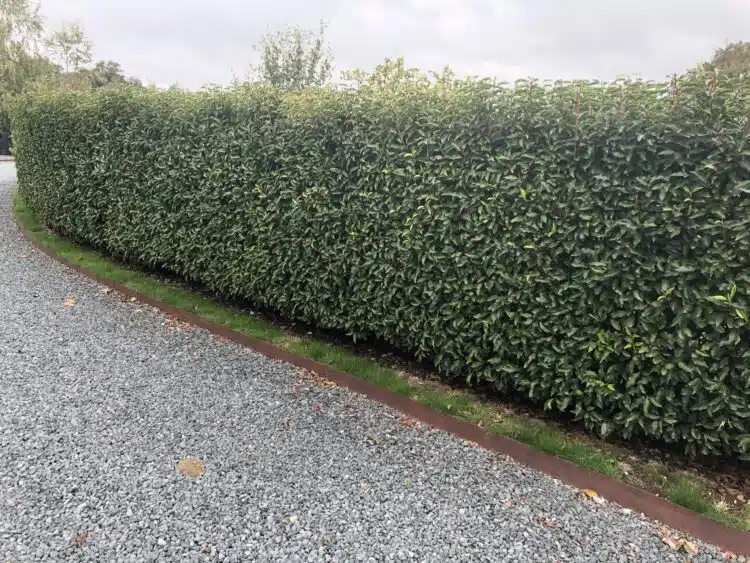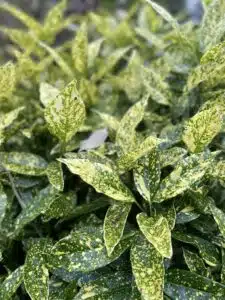*HALF PRICE SALE NOW ON – TAKING ORDERS FOR JANUARY DELIVERY*
ORDER ONLINE OR CALL OUR FRIENDLY TEAM ON 01580 765600
Menu
*HALF PRICE SALE NOW ON – TAKING ORDERS FOR JANUARY DELIVERY*
ORDER ONLINE OR CALL OUR FRIENDLY TEAM ON 01580 765600
 https://www.hopesgrovenurseries.co.uk/wp-content/uploads/2024/03/Hedge-pf-Portuguese-Laurel-Prunus-lusitanica-Angustifolia-750x563.jpeg
Portugues Laurel Hedge Prunus lusitanica 'Angustifolia'
https://www.hopesgrovenurseries.co.uk/wp-content/uploads/2024/03/Hedge-pf-Portuguese-Laurel-Prunus-lusitanica-Angustifolia-750x563.jpeg
Portugues Laurel Hedge Prunus lusitanica 'Angustifolia'
Green is such an important colour in the garden. In winter it provides warmth and reassurance, like a beating heart ticking away while the rest of the garden slumbers. In summer, it’s the complete opposite. Rich-green cools and soothes the garden and the gardener alike, acting as a backdrop or shade caster. The rich foliage complements pallid and white flowers, which are so difficult to place in bright sunlight. The foliage is also a perfect foil for warmer colours, such as golden-yellow, cobalt-blue and fiery reds and oranges. Or you can create a foliage garden, reminiscent of Italy, with shade-loving oak ferns, Dryopteris, or smaller evergreens such as sarcococca or Euonymus fortunei.
Cherry laurel, Prunus laurocerasus, is one of the glossiest and greenest evergreens for hedging and screening. It’s fast growing and bushy and it could form a 2m high hedge within six years – if the soil is well-prepared. Adding bonemeal to the planting hole and mixing it in will promote good root development. One kilo of bone meal should be enough for 15 metres of Common Laurel hedging plants. However, bonemeal is an excellent root-booster for everything from dahlias to asters. Rootgrow, which contains mycorrhizal fungi, will increase nutrient and water uptake through a highly efficient fine root system. They’ll both help enormously.
You can plant bare-root, two-year old plants between November and March, or you can use pot-grown two-year old plants throughout the year. Space them out, using three per metre. If time is of the essence, use instant hedging grown in ready-to-plant troughs. Whatever you go for, always cosset newly planted hedges for their first growing season, watering them well in dry growing seasons. A dribbling hose won’t do. Watering cans and buckers are best in smaller areas. If that’s too much of an ask, I’m a big fan of soaker hoses – porous lengths of rubber. Go to Hozelock’s website.
Once your cherry laurel hedge is hydrated and up and growing it will provide privacy throughout the year. It will clean up air pollution and soften those annoying noises many of us have to live with. It’s able to tolerate shady positions, even shrugging off dripping water from overhead trees. Windy conditions don’t seem to bother cherry laurel either. It seems incongruous that a plant that looks so lush and soft and green is, in fact, a real toughie. That’s partly provenance, because cherry laurel is a widespread native found in eastern Europe and south-west Asia. It tolerates a wide range of soils, although it’s not happy on thin chalk and it doesn’t enjoy having water-logged roots.
Cherry Laurel has been grown here since 1578 and it has naturalised because the red cherry-like fruits, which eventually mature to black, produce unwanted seedlings. These are spread around when birds ingest the fruit and they are passed in the bird’s droppings, with their own fertiliser. Regular cutting, twice a year, removes the flower buds and the threat of bird-sown seedlings in the wild. If you’re near woodland, those regular twice-yearly trims are really important, because cherry laurel can become invasive.

There are several named forms. ‘Rotundifolia’, literally meaning round foliage, is a bushier version that arrived here in 1865, during the Victorian era. It became an instant success because it’s bushier with rounder foliage. ‘Etna’ arose as seedling in 1993 in Germany, and it’s distinctly different because the young foliage is a warm, coppery orange – conjuring up cooling volcanic lava. The foliage ages to dark-green as it matures. ‘Etna’ is more tolerant of difficult, cold and exposed sites due to its German provenance. They have chilly winters. It will form a shorter hedge, up to 2.5m, and it’s slower growing 
Trim ‘Etna’ in autumn, ideally, so that you can enjoy the burnished new growth next spring. If you want to prune it twice, give it an early summer clip as well and then you should get a flash of new coppery growth in autumn. ‘Etna’ is available in pots, for year-round planting, or it’s sold as root-ball plants in the dormant season, for planting between October and early May. Use 3 per metre.
It’s not the only laurel on offer. The Portuguese laurel, Prunus lusitanica ‘Angustifolia’, can be used as a hedge, or it can be topiarised to great effect. I used to admire twelve rectangular ‘Apostles’ in a garden that used to be open. They made a huge impact throughout the year, twelve solid blocks of green, and they glowed in winter light. The dark-green foliage was held on contrasting red stems and petioles and the red-green mixture is a very festive combination in midwinter light.
The small white flowers of Portuguese laurel have a cakey hawthorn scent and this ‘garden designer favourite’ is versatile and tough. It can be clipped into a mophead, or an umbrella, or it can be cut into cubes or cones. You can also allow it to develop into a small tree, au naturel. Better still, Portuguese laurel tolerates chalky and sandy soils and it’s also hardier than the cherry laurel is.
Portuguese laurel copes with bright sunshine and wind really well. Deep shade, which is no problem for cherry laurel, doesn’t suit Portuguese laurel however. It begins to get thin and weedy looking. You get three bites when it comes to planting Portuguese laurel. You can do instant hedging grown in troughs. These instant hedges are used in Chelsea Show Gardens again and again and they look as they they’ve been there forever!
You can plant root-ball hedging plants in the dormant season between October and early May. These have been grown in their own wide space, so they have developed a good shape. They haven’t been cramped by close neighbours. Leave the hessian on the root ball when planting: it will rot away naturally. If you’re planting in the growing season, opt for potted plants and these come in a variety of sizes from 9cm potfuls to large plants in 150cm pots. If you’re using small pots, opt for a double row of 5 per metre. It will be quicker.
There’s also a compact form of Portuguese laurel, named ‘Brenelia’. The glossy mid-green foliage has wavier leaf edges and ‘Brenelia’ also displays brighter red on the new growth. It will reach 3m or 9ft eventually and can used as a hedge, or it can be allowed to develop into a conical shrub. It also clips well.
Japanese laurel, Aucuba japonica, was another Victorian favourite because this long-lived shrub forms rounded metre wide and metre high bushes regardless of soil or situation. ‘Variegata’ was introduced from Japan in 1793 and it has female flowers so it can berry if there’s suitable male nearby. Male and female flowers are held on separate plants, a condition known as dioecious – literally two houses.

Japanese laurel featured heavily at English Heritage’s Brodsworth Hall near Doncaster in Yorkshire. Some of the bushes were originals, planted in the 1860s. This garden was designed to look Italianate, because the owner Charles Thellusson was born in Florence in 1822. He spent his childhood in fashionable Brighton and was the eventual heir to a famously disputed fortune, over which a protracted, very public battle was fought in the High Court for almost 60 years. The dispute partly inspired Jarndyce and Jarndyce, the interminable case at the heart of Charles Dickens’s Bleak House.
Brodsworth Hall was occupied by the family continuously, but the house and gardens had
gone into a steady decline. They were given to English Heritage in 1988 and one of the many tasks was reclaiming the once-magnificent garden. The Italianate Garden had become a gloomy, overgrown jungle, with the occasional glimpse of an Italian statue hinting at the garden’s former glory.
Aucuba, box, laurustinus and Portuguese laurel, widely used by the Victorians, underpinned the scheme throughout the garden and many of these originals were on their last legs. They were cut back hard and soon bounced back, despite being centenarians. www.english-heritage.org.uk for further information.
It’s also worth having a bay laurel in a sheltered part of the garden. The Latin name, Laurus nobilis, hints at a classical tradition for crowning heroes with a wreath made from the aromatic leaves – hence the species name nobilis. This Mediterranean plant will thrive close to the coast, because the leathery leaves resist salt burn and wind. Those of us in colder parts will have to find a sheltered calm position, or we’ll have to grow it in a pot.
Being tender means that late-spring pruning is the best method of trimming it, although they are slow growing. Move it up a pot size every year, just a touch larger and it will reward you with its aromatic foliage. A winter stew, with the addition of two freshly picked bay leaves, is reason enough to grow one!
Pleached trees are a garden-design favourite, because they provide an instant leafy screen that looks stylish as soon as it’s planted. They offer privacy for you and they help to muffle noise and that’s becoming more important in our busy world. They provide a living screen that’s far more eco-friendly than a stark wooden fence…
Green is such an important colour in the garden. In winter it provides warmth and reassurance, like a beating heart ticking away while the rest of the garden slumbers. In summer, it’s the complete opposite. Rich-green cools and soothes the garden and the gardener alike, acting as a backdrop or shade caster. The rich foliage…
Gardeners are nurturers by nature: it goes with the job description! We care for plants and, hopefully, they grow for us. We’re also in tune with nature, simply because we’re outside an awful lot. When we’re looking at our plants, we notice the spiders, the bees and the butterflies. They are the living layer: the…